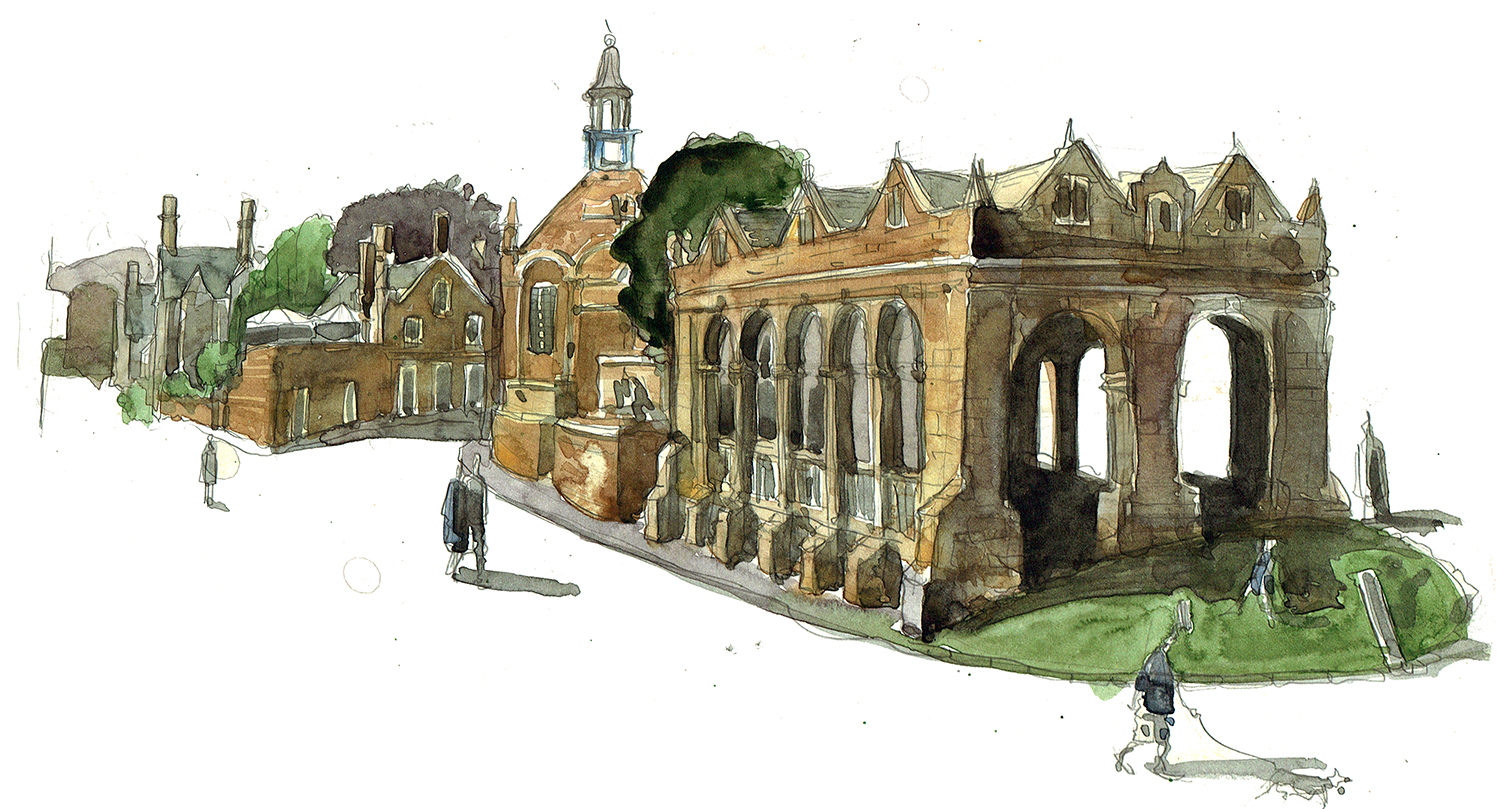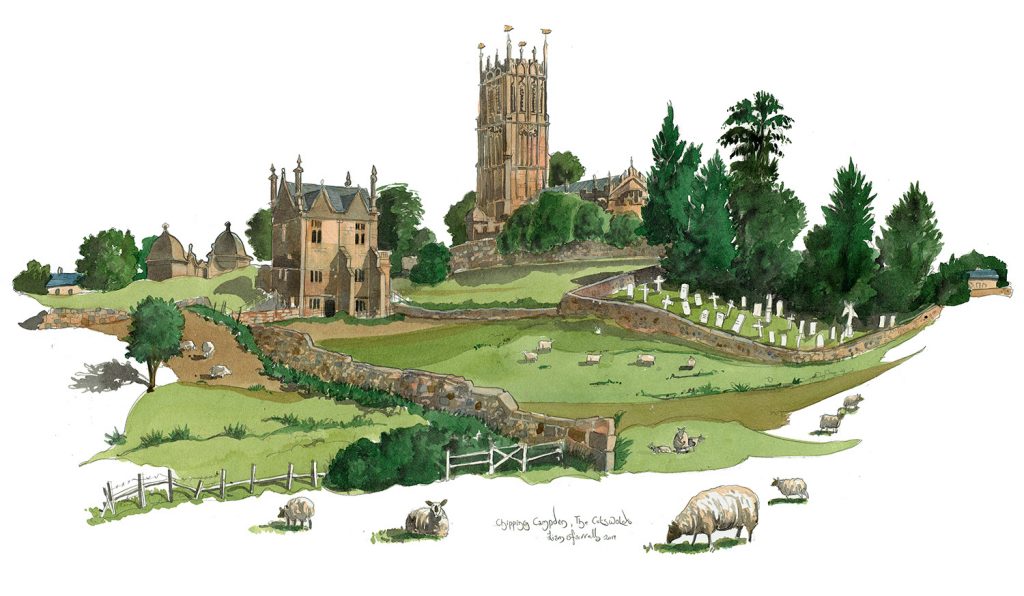During the summer I got a commission to go and paint a scene in Chipping Campden in The Cotswolds.
I used to visit Chipping Campden regularly about ten years ago as I exhibited in the village of Broadway just up the road. I was looking forward to stopping by again to push a bit of paint about.
By happy coincidence I was also commissioned to paint Worcester Cathedral too so I thought I would do a circular trip over two days. Worcester on the first day, stay overnight then pay a visit to Chipping Campden on the following day. So after my Worcester visual was sorted I headed to The Cotswolds.
Painting Chipping Campden
I drove down the High Street and it was as busy as I remembered it. I managed to find a parking space by the Market Hall and pulled in. I later found out it was a pay and display car park though I didn’t see the machine. I didn’t get a ticket either – Ha!
It’s difficult to believe now, though in the early medieval period and for some centuries afterwards Chipping Campden was a bit of a boom town. Prospective merchants used to come here to make their fortunes in the prosperous wool trade and this is when many of the fine Cotswold Stone buildings were constructed. Over time the global competition in wool production put the area into decline with only the honey tinted buildings remaining to remind us of its once glorious past. These days you must become rich to live in Chipping Campden not the other way around.
Chipping Campden is of course not like London where you’d say, ‘I hardly recognised the place!’ because nothing changes. It’s all preserved in Cotswold amber. It’s a rather small town but still manages to boast 256 historically Listed buildings from small to very large indeed.
How towns like this produced and keep so many buildings of historical interest I can’t say – even the terraced High Street goes back to the 14th century. My client gave me a pretty broad brief on what to paint, so I was blessed with an architectural cornucopia to choose from.
The Market Hall
 I had a bit of a wander about and decided to have my first go at The Market Hall near where I parked the car.
I had a bit of a wander about and decided to have my first go at The Market Hall near where I parked the car.
It was built in 1627 Sir Baptist Hicks and is of course still in use today. I initially assumed it was for the selling of wool although as it turned out, it was built for the selling of regular produce such as eggs, butter, bread and so on. It was going to be sold off in the 1940’s so the locals bought it and it is now owned by The National Trust which should be able to keep it going for another 400 years or so.
I set up my watercolour easel at the side of the road between two cars where I would be out of the way as the path here is narrow with tourists blindly charging up and down in mid selfie.
At this stage I was just painting small ideas to give the client an indication of the final piece. That said, when you draw something you really get an idea of the care taken by the architect to make this utility building looking as fine as possible.
I am especially impressed by reduction of pillar heights to consider the shape of the land. To me at least it would have been easier to level the land out as they did at the other end of the structure. The Romans wouldn’t have stood for such flagrant lack of symmetry although I much prefer it being sensitive to nature, ensuring this feature was present in my visual.
My first visual done I have to say at this point was feeling a bit lazy. After-all I had just stepped out of my car and painted the first thing in front of me. To give client a good deal I would go on a bit of an odyssey for the next painting. Packing away my kit I moved off up The High Street for a look about. I eventually came to Calf Lane and went in search of a Public Footpath or two.
As I live in a rural area I know that Public Footpaths can be tricky to find although in The Cotswolds you are helped to a degree by the multitudinous signs which read ‘KEEP OUT’, PRIVATE LAND’, NO TURNING’, ‘NO TRESPASSING’ and so on. So, rather like a human pinball I bounced off each authoritarian sign until I come across one that said, ‘Public Footpath’ and you knew that this was the one for me. I am the ‘Public’.
I clambered over a style and into the field beyond. I could just trace a walker’s mark in the grass which I followed. It did however quickly disappear and I was eventually just in a field with a load (flock) of sheep contemplating whatever it is sheep contemplate. The sheep came right up close so must be well used to humans. In Somerset where I live, they are very timid and will scare very quickly.
I was about to go back the way I came when I saw an ideal view. It was of St James church with a few scattered ruins.
St James Church, Chipping Campden
Although there was a church on this site since at least 1180, this incarnation was built in the 15th Century with bits added over time. For example, the clock mechanism dated 1695 and the peal of eight bells, whose dates vary from AD 1618 to AD 1737. Its is a lovely building and the tower can be seen for miles around.
To the left you can see the extraordinary Jacobean Banqueting House built by Sir Baptist Hicks in 1613 as part of his larger house, later destroyed in the English Civil War. Today the Banqueting House is marooned out in a field on its own which gives it a rather solitary aspect.
I set up my easel again and got to work. My companions, the sheep, must spend most of the day utterly bored as I became the centre of attraction. They slowly gravitated toward me as I worked until I must have looked like a shepherd to any casual observer.
I was happy with the result on this one and indeed it was the one the client chose for a final painting. I was keen to get back home once so I scattered the sheep and moved directly towards where I thought the car was parked…
…Damn the signs!





5 comments:
Amazing that there are so many listed bldgs there—sounds like the entire town. Very happy that you kept walking and found the wonderful site to paint.
Yes its a great place to paint. The Cotswolds is full of such places!
Many thanks Susan
Hope you are keeping well
Best wishes
Liam
My great grandmother, Constance Jane Innes, wife of Inverness lawyer Charles Innes died on a visit south of the Border, at Chipping Camden.
When walking the first leg of the Cotswold Way to Broadway Tower 10 years ago we located her memorial cross, under a thicket of brambles in the churchyard.
BW
Hi Richard
That’s a very interesting story, sad about the death though there can be few places better to be buried. The whole area is lovely.
I went up the Broadway tower. Id paint the view but didn’t have all week!
Best wishes
Liam